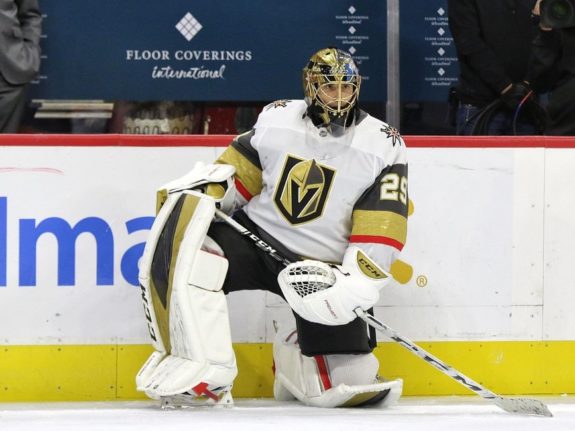In Wednesday night’s 5-1 victory over the Minnesota Wild, Vegas Golden Knights forward Chandler Stephenson scored a goal and added an assist, bringing his total points with the club to 34 in 60 games. That would not be a notable feat in and of itself, except for the fact that the 26-year-old had previously registered 33 points in 168 games with the Washington Capitals.

That’s right, Stephenson has already tallied more points as a Golden Knight than as a Capital despite playing 108 more games in D.C. You might chalk that up to age-related progression and development or an increased role, but that type of surge in performance has become surprisingly commonplace among incoming Knights.
Expansion Draft Impact
As you might expect, the 2017-18 expansion season looms large in this trend. Of the 21 skaters who were around for Vegas’ entire inaugural campaign and played at least 10 games, all but three (Oscar Lindberg, William Carrier and Jon Merrill) improved their scoring output from the previous season.
But even on a bad expansion team, a widespread uptick in performance could be anticipated based on players assuming greater roles and gaining more ice time than they would have with their old club. Of course, the Stanley Cup Final-bound Golden Knights were anything but a bad expansion team, and those largely unwanted castoffs wound up providing key contributions to the eventual Western Conference champions.
Then-general manager George McPhee deserves credit for an expansion draft strategy in which he identified available young players from other organizations who were primed for a breakout. While he certainly didn’t hit on all of them, many of the success stories from that first year came from players who improved greatly amidst new surroundings.
Vegas’ Breakout Stars
No one from that 2017-18 team broke out in quite the same way as William Karlsson. ‘Wild Bill’ won the Lady Byng trophy and finished among the top-10 vote-getters for the Hart and Selke awards after scoring 43 goals, tallying 78 points and finishing an NHL-best plus-49. While the 28-year-old has experienced some regression since, he remains a top-six, two-way center and steady point producer.

While no one else has emerged seemingly from out of nowhere in quite the same way as Karlsson made his year one splash, the Golden Knights’ development system has bore fruit with a number of players elevating themselves as high-end NHL players in the franchise’s four years of existence. Stephenson, Shea Theodore, Alex Tuch, Erik Haula and Nate Schmidt are all examples of players who made a substantial jump while plying their trade for Vegas.
Now, stories of breakout successes in Vegas tend to follow a more typical path as homegrown talent rises through the system to make their mark. This year, it’s been Zach Whitecloud and Nic Hague who have established themselves at the NHL level, with a countless array of others in Henderson, on the taxi squad and abroad working their way towards Vegas.
The Vegas Bump
Not every Golden Knights’ performance spike, however, has been engineered by a breakout player. The organization has also benefited from some veteran rejuvenation – experienced players finding new life once they dawn the black, red and gold.
Take Marc-Andre Fleury, who is currently enjoying a second career renaissance with the club. The Pittsburgh Penguins left their three-time Cup-winning netminder exposed in the expansion draft after he registered a .909 save percentage and 3.02 goals against average while generally looking washed up in 2016-17. One year later, and those numbers had improved to .927 and 2.24, respectively, as he backstopped the Knights to the Cup Final.

Apparently, teammate Max Pacioretty drank from that same fountain of youth, as he rebounded from 37 points and a minus-16 in the final season of his long tenure with the Montreal Canadiens to record 32 goals, 66 points and a plus-18 last season in Vegas. In that same vein, linemates Jonathan Marchessault and Reilly Smith had both produced standout numbers during their time with the Florida Panthers but really came into their own with the Golden Knights.
For much of their existence, the ‘Vegas Effect’ (or the ‘Vegas Flu’) has been understood to be a cautionary tale for opposing teams about having too much fun while visiting Sin City – in non-COVID times, of course – and not being at 100% come game time. Perhaps, though, the effect has more to do with some kind of boost players get from becoming Golden Knights. It’s certainly been working thus far.